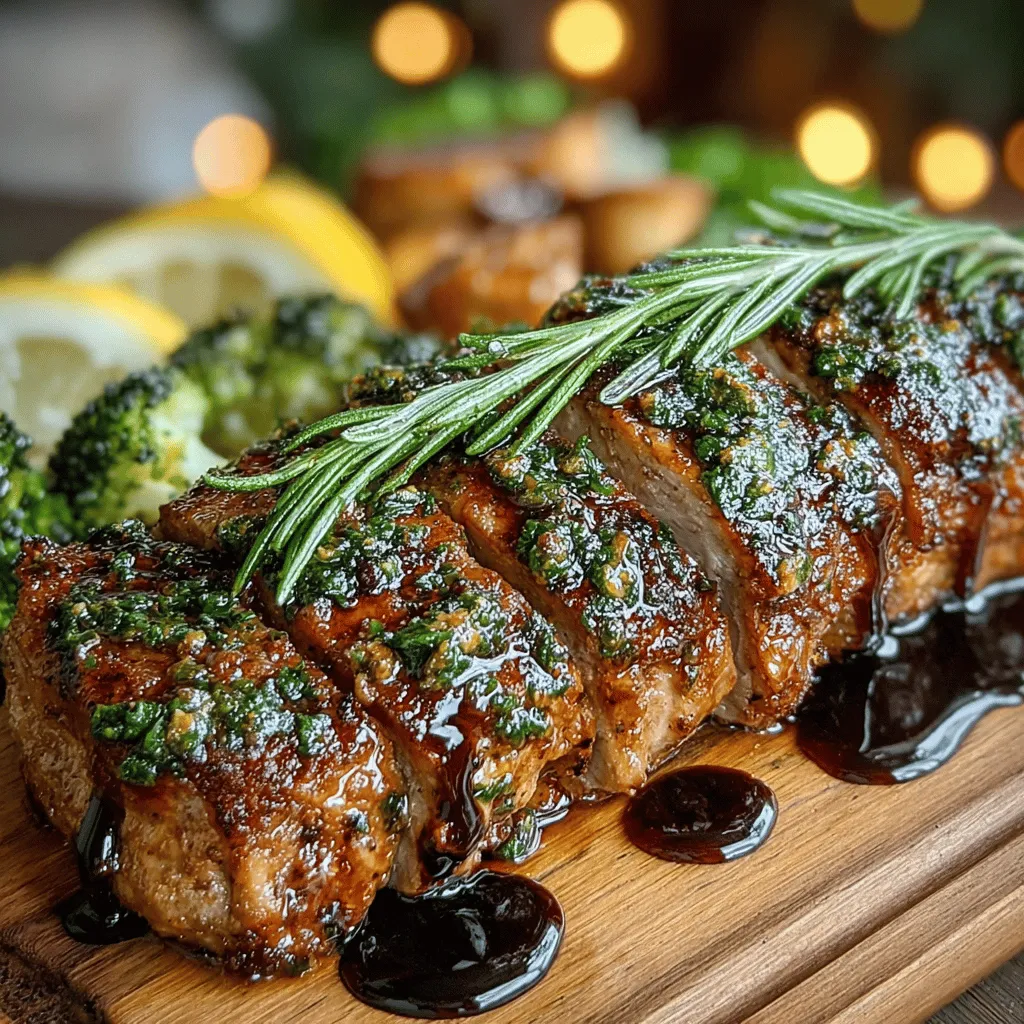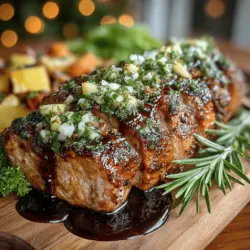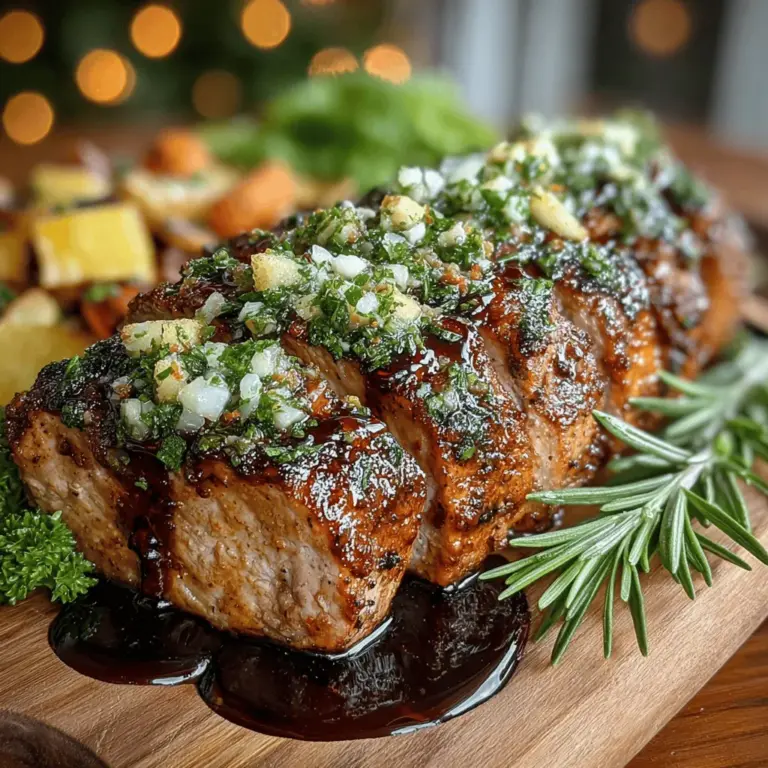Garlic Herb Roasted Pork Tenderloin: A Delightful Culinary Adventure
When it comes to versatile cuts of meat, pork tenderloin stands out as a favorite among home cooks and culinary enthusiasts alike. Known for its tenderness and subtle flavor, pork tenderloin provides a blank canvas for a variety of seasonings and cooking methods. One of the most delightful ways to prepare this cut is through roasting, and when it’s infused with the robust flavors of garlic and fresh herbs, it transforms into a dish that’s not only simple to prepare but also impressive enough for special occasions.
The magic of Garlic Herb Roasted Pork Tenderloin lies in its ability to highlight the natural flavors of the pork while adding layers of complexity through the use of aromatic garlic and vibrant herbs. This dish is an invitation to elevate your cooking game, offering a tantalizing aroma that fills your kitchen and a taste that lingers on your palate. As we embark on this culinary journey, you’ll discover just how easy it is to create a meal that is both comforting and sophisticated.
Understanding Pork Tenderloin
Pork tenderloin is a long, thin cut of meat that comes from the muscle that runs alongside the backbone of the pig. This cut is renowned for its tenderness—it’s one of the most tender parts of the animal, making it a prime choice for quick cooking methods like roasting or grilling. Compared to other pork cuts, such as shoulder or loin, the tenderloin boasts a milder flavor, which makes it incredibly versatile. Its neutral profile allows it to pair beautifully with a range of seasonings, from sweet to savory.
For home cooks seeking a lean option, pork tenderloin is an excellent choice. It is lower in fat than many other cuts, making it a healthier alternative without sacrificing flavor. In addition to being a great source of protein, pork tenderloin is loaded with essential vitamins and minerals, including B vitamins, selenium, and zinc. These nutritional benefits, combined with its culinary versatility, make it a staple in many kitchens.
Ingredients Overview
To create the perfect Garlic Herb Roasted Pork Tenderloin, selecting the right ingredients is crucial. Here’s a closer look at the key components that will bring this dish to life:
– Pork Tenderloins: When choosing pork tenderloins, look for cuts that are pink and firm to the touch. Freshness is key—avoid any that appear discolored or have an off smell. Opting for high-quality, pasture-raised pork can also enhance the flavor and texture of your dish.
– Garlic: Often referred to as nature’s antibiotic, garlic not only boosts the flavor of your roasted tenderloin but also offers numerous health benefits. It contains compounds that may support heart health and boost the immune system. When using garlic in this recipe, the objective is to achieve a fragrant and slightly sweet flavor that complements the pork beautifully.
– Fresh Herbs (Rosemary, Thyme, Parsley): The use of fresh herbs is paramount in this recipe. Fresh rosemary and thyme impart earthy notes, while parsley adds a hint of brightness. Fresh herbs are generally more potent than their dried counterparts, so using them in this dish will elevate the flavors significantly. When preparing the marinade, finely chopping these herbs will help release their essential oils, ensuring their flavors infuse thoroughly into the pork.
– Olive Oil: As a staple in Mediterranean cuisine, olive oil plays a dual role in this recipe. Not only does it help to create a delicious marinade, but it also aids in the cooking process, helping to achieve a golden-brown exterior while keeping the meat moist. Additionally, olive oil is rich in healthy monounsaturated fats and antioxidants, making it a heart-healthy choice.
– Lemon and Balsamic Vinegar: Both lemon juice and balsamic vinegar introduce acidity to the marinade, which is essential for flavor balance. The acidity from these ingredients can help tenderize the meat while also enhancing the overall taste of the dish, making it brighter and more vibrant.
Preparation Steps for Garlic Herb Roasted Pork Tenderloin
Once you’ve gathered your ingredients, the next step is to prepare your Garlic Herb Roasted Pork Tenderloin. The preparation process starts with preheating your oven to ensure it reaches the optimal temperature for roasting.
– Preheating the Oven: Start by preheating your oven to 400°F (200°C). This temperature is ideal for roasting pork tenderloin, allowing the meat to cook evenly while developing a beautiful caramelized crust. Preheating is essential, as it ensures that the pork begins cooking immediately upon being placed in the oven, preserving its juices and tenderness.
– Preparing the Marinade: To create the marinade, combine minced garlic, finely chopped fresh herbs (rosemary, thyme, and parsley), olive oil, lemon juice, and balsamic vinegar in a bowl. The proportions can be adjusted based on personal preference, but a good starting point is to use about three cloves of garlic, one tablespoon each of chopped herbs, and two tablespoons of olive oil, along with the juice of half a lemon and a splash of balsamic vinegar.
– Step-by-Step Process of Creating the Marinade: Begin by mincing the garlic as finely as possible to ensure it distributes evenly throughout the marinade. Next, chop the fresh herbs and add them to the bowl. Pour in the olive oil, lemon juice, and vinegar, then whisk the mixture until well combined. This marinade not only serves to flavor the pork but also helps to keep it moist during the roasting process.
– Tips for Marinating: For maximum flavor infusion, let the pork tenderloin marinate for at least 30 minutes, but ideally, aim for 2 to 4 hours. If time allows, refrigerating the marinated tenderloin overnight will yield even more robust flavors. Remember to cover the pork with plastic wrap or place it in a sealed container to prevent any cross-contamination and to allow the flavors to meld effectively.
With the oven preheated and the marinade prepared, you are well on your way to creating a Garlic Herb Roasted Pork Tenderloin that is not only delicious but also a feast for the senses. This dish brings together the best of culinary simplicity and the elegance of a home-cooked meal, making it perfect for any occasion. As you venture into the next steps of the recipe, you’ll find that the process is as rewarding as the final result.

Garlic Herb Roasted Pork Tenderloin is a mouthwatering dish that brings together succulent pork, fragrant herbs, and the rich aroma of garlic. This recipe not only highlights the natural flavors of the pork but also elevates it to a dish that is both simple enough for a weeknight dinner and elegant enough for a special occasion. Let’s dive into the steps for marinating, searing, roasting, and serving this delicious meal.
Marinating the Pork
Techniques for Evenly Coating the Pork
To achieve a flavorful and aromatic Garlic Herb Roasted Pork Tenderloin, the marinating process is crucial. Start by preparing your marinade, which typically consists of minced garlic, fresh herbs such as rosemary and thyme, olive oil, salt, and pepper. Once your marinade is ready, place the pork tenderloin in a resealable plastic bag or a shallow dish. Pour the marinade over the pork, ensuring it is thoroughly coated.
For even flavor distribution, massage the marinade into the meat, pressing it into the surface. This step helps the herbs and garlic penetrate the pork, enhancing its flavor profile. If time allows, marinate the pork in the refrigerator for at least 30 minutes, although a longer marinating time—up to overnight—will yield even better results. The longer the pork sits in the marinade, the more tender and flavorful it becomes, thanks to the acid in the marinade breaking down the meat fibers.
Discussion on the Impact of Marinating Time on Flavor and Tenderness
Marinating not only infuses the pork with flavor but also contributes to its tenderness. The acid in the marinade, whether from citrus juice or vinegar, helps to break down tough muscle fibers, resulting in a more tender bite. Ideally, aim for a marinating time of at least one hour; however, for maximum flavor depth and tenderness, consider marinating overnight. This gives the pork ample time to absorb the herbs and garlic, resulting in a dish that bursts with flavor.
Searing the Pork
Explanation of the Searing Process and Its Importance in Flavor Development
Once marinated, the next step is to sear the pork tenderloin. Searing is the process of cooking the meat at a high temperature to create a flavorful, caramelized crust on the surface. This Maillard reaction not only enhances the taste but also locks in the juices, ensuring that the pork remains moist during cooking.
Heat a large skillet over medium-high heat and add a splash of olive oil. Once the oil is shimmering, carefully place the marinated pork tenderloin in the skillet. Avoid overcrowding the pan, as this can lead to steaming instead of searing. Allow the pork to cook undisturbed for about 3-4 minutes on each side, or until a golden-brown crust forms.
Tips for Achieving the Perfect Golden-Brown Crust
Achieving a perfect golden-brown crust is essential for the overall flavor and presentation of the dish. Here are some tips for perfect searing:
1. Preheat the Pan: Ensure your skillet is adequately heated before adding the pork. A hot pan creates a better sear.
2. Pat Dry: Before marinating, pat the pork tenderloin dry with paper towels. Moisture on the surface can prevent a good sear.
3. Do Not Move the Meat: Once you place the pork in the pan, avoid moving it around. Let it sit long enough to develop a crust.
4. Use a Meat Thermometer: For optimal results, use a meat thermometer to check the internal temperature. This ensures the pork is cooked to perfection.
Roasting the Pork Tenderloin
Transferring to the Oven: How to Properly Place the Pork in the Roasting Pan
After searing, transfer the pork tenderloin to a roasting pan. If you have used the same skillet, consider deglazing it with a bit of chicken broth or white wine to capture all those flavorful browned bits before pouring the liquid over the pork in the roasting pan. Place the tenderloin in the center of the pan, ensuring there is space around it for even cooking and air circulation.
Roasting Time and Temperature: Guidelines for Checking Doneness
Preheat your oven to 400°F (200°C). The ideal internal temperature for pork tenderloin is 145°F (63°C). Roast the pork for approximately 20-25 minutes, depending on the size of the tenderloin. To ensure accurate cooking, insert a meat thermometer into the thickest part of the pork. Once it reaches the desired temperature, remove it from the oven.
Understanding Carryover Cooking
It’s important to note that once the pork is removed from the oven, it will continue to cook slightly due to residual heat. This phenomenon, known as carryover cooking, can raise the internal temperature by about 5°F (3°C). To avoid overcooking, consider removing the pork from the oven when it reaches an internal temperature of about 140°F (60°C). Allowing the pork to rest will bring it up to the perfect serving temperature.
Resting and Serving the Pork
Importance of Resting Meat: How Resting Affects Juiciness and Tenderness
After roasting, let the pork tenderloin rest for 10-15 minutes before slicing. This resting period is crucial, as it allows the juices to redistribute throughout the meat, resulting in a juicier and more tender final product. If you slice the pork too soon, the juices will escape, leading to dry meat.
Slicing Techniques: Best Practices for Slicing Pork Tenderloin into Medallions
When ready to serve, use a sharp knife to slice the pork tenderloin into medallions, about 1-inch thick. Make sure to cut against the grain; this technique will ensure each slice is tender and easy to chew. Arrange the medallions on a serving platter, overlapping them slightly for an elegant presentation.
Presentation Tips: Ideas for Arranging on a Platter and Garnishing with Herbs
For an appealing presentation, consider garnishing the pork with fresh herbs like parsley or thyme. You can also drizzle a bit of the pan juices over the medallions for added flavor and moisture. Pair the pork with colorful roasted vegetables or a fresh salad to enhance the visual appeal of the dish.
Pairing Suggestions for Garlic Herb Roasted Pork Tenderloin
Recommended Side Dishes: Roasted Vegetables, Mashed Potatoes, and Fresh Salads
Garlic Herb Roasted Pork Tenderloin pairs beautifully with a variety of sides. Consider serving it with roasted seasonal vegetables, such as Brussels sprouts, carrots, or asparagus, to complement the flavors of the dish. Creamy mashed potatoes are another excellent choice, as their richness balances the savory notes of the pork. For a lighter option, a fresh salad with mixed greens, cherry tomatoes, and a tangy vinaigrette can make for a refreshing contrast.
Wine Pairings: Suggestions for Wines That Complement the Flavors of the Dish
When it comes to wine pairings, consider a medium-bodied red wine, such as Pinot Noir or Merlot, which complements the savory flavors of the pork without overpowering it. Alternatively, a crisp white wine like Sauvignon Blanc or Chardonnay can also enhance the dish’s herbal notes and provide a refreshing contrast.
Conclusion
In summary, preparing Garlic Herb Roasted Pork Tenderloin is a straightforward yet rewarding endeavor that results in a flavorful and elegant dish. By following the key steps—marinating the pork for optimal flavor, searing for a delicious crust, and properly roasting to achieve the perfect doneness—you will create a meal that is sure to impress. The resting process ensures juicy, tender slices, while thoughtful presentation elevates the dish for any occasion. We encourage you to try this recipe and enjoy the delightful flavors it brings to your table, making it a favorite for both casual dinners and special gatherings.

